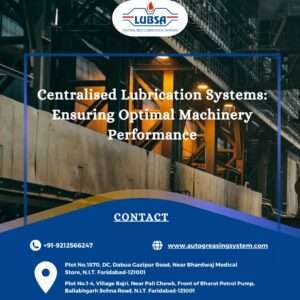Centralised Lubrication Systems: Ensuring Optimal Machinery Performance

Making sure industrial gear operates smoothly and efficiently is essential. The longevity and proper operation of large machinery are contingent upon Centralised lubrication systems. Optimizing machinery performance requires knowing the importance of lubricating systems and their many components, whether you’re looking for a manufacturer or supplier.
In many different sectors, the Centralised Lubrication Systems is essential to the seamless functioning of machinery and equipment. We’ll examine Centralised lubrication systems, their benefits, and the significance of choosing a trustworthy manufacturer and provider of lubrication systems.
Understanding Centralised Lubrication Systems
Multiple places inside a machine or system can get lubricants automatically thanks to Centralised lubrication systems. By doing away with the necessity for manual lubrication, these systems guarantee sufficient and reliable lubrication of vital components. A deeper look at the main features of centralised lubrication systems is provided below:
Types of Centralised Lubrication Systems
Centralised lubrication systems come in a variety of forms, each meeting distinct industrial needs. Among the principal kinds are:
Single-Line Systems: In these systems, lubricant is distributed to various locations via a network of distribution lines using a single main supply line.
Dual-Line Systems: In order to maintain dependability and safety in crucial applications, dual-line systems switch the lubricant supply between two main lines.
Progressive Systems: Designed for applications with diverse lubrication requirements, progressive systems use a sequence of injectors to feed lubricant to various places consecutively.
Circulating Oil Systems: Systems that circulate oil constantly between components to provide both lubrication and cooling at the same time are known as circulating oil systems.
What are the components of a centralised lubrication system?
Selecting the appropriate lubrication system manufacturer or supplier requires an understanding of the components of a Centralised lubrication system. Together, these elements guarantee the accurate distribution of lubricants:
Lubricant reservoir: By storing the lubricant, the reservoir makes sure the system has a steady supply.
Pump Unit: The pump unit is in charge of pressurizing the lubricant and distributing it to the distribution points throughout the system.
Distribution Lines: These lines transfer lubricant from the pump unit to each piece of machinery where it is needed.
Metering Valves: To ensure uniform distribution, metering valves control the amount of oil administered to each lubrication point.
Injectors or Lubrication Points: The essential places where lubricant is supplied to lubricate machine parts are called injectors or lubrication points.
What is the fundamental role of centralised lubrication systems?
A machine or piece of industrial equipment might have several lubrication locations thanks to Centralised lubrication systems. This automated and regulated lubrication procedure has several significant advantages:
Increased Lifespan of Equipment: Lubricating equipment properly reduces wear and tear on important parts, which increases machinery life.
Decreased Downtime: Lubricating continuously lowers wear, heat, and friction, which results in fewer shutdowns for maintenance.
Cost-Efficiency: By using lubricants more effectively, Centralised lubrication systems lower total maintenance costs.
Increased Safety: By lowering the possibility of mechanical breakdowns, regular lubrication increases the safety of equipment.
What are the advantages of centralised lubrication systems?
Because of their many benefits, Centralised lubrication systems are essential in industrial environments.
Enhanced Equipment Life: Regular lubrication helps machinery and equipment last longer, which lowers maintenance costs and downtime.
Enhanced Equipment Efficiency: By ensuring that each lubrication point receives the necessary quantity of lubricant, Centralised systems maximize the performance of machinery.
Reduced Manual Labor: Automation improves worker efficiency and safety by doing away with the necessity for manual lubrication.
Precise Lubrication: By offering precise control over the quantity and timing of lubricant distribution, Centralised systems lessen waste and their negative effects on the environment.
Industries Benefiting from Centralised Lubrication Systems
Many industries use Centralised lubrication systems, such as the following:
Manufacturing: These systems guarantee the effective operation of industrial equipment and minimize downtime in manufacturing operations.
Automobile: To ensure efficient and dependable manufacturing, Centralised lubrication is essential for automobile assembly lines.
Mining: Centralised systems aid in preventing costly downtime and equipment breakdowns in the harsh and demanding environment of mining operations.
What is the role of a lubrication system supplier?
For Centralised lubrication systems to be implemented successfully, choosing the appropriate lubrication system provider is essential. Why it’s important to have a trustworthy Lubrication Systems Supplier in India.
Product Variety: To satisfy the various demands of the business, a trustworthy provider provides a selection of Centralised lubrication systems.
Technical Support: Appropriate system selection, installation, and maintenance are ensured by the supplier’s knowledgeable support.
Assurance of Quality: Reducing the likelihood of malfunctions and breakdowns, a reliable supplier offers top-notch systems and components.
Tailored Solutions: Skilled providers may provide customized solutions to meet particular lubrication needs across various sectors.
The Importance of Choosing a Trusted Manufacturer
Selecting a trustworthy Centralised Lubrication System Manufacturer is just as essential as choosing a dependable supply. This is the reason why:
High-quality products: Reputable producers provide long-lasting, enduring components.
Innovation: Top producers frequently provide advanced solutions and are at the forefront of technical breakthroughs.
Customization: Reputable manufacturers are able to modify systems to meet particular needs and deliver top-notch results.
Warranty and Support: To provide customers with peace of mind, manufacturers usually provide warranties and thorough support for their goods.
Centralised lubrication systems are essential to preserving the lifespan and functionality of industrial machinery. Making an informed choice requires knowing the parts, advantages, and uses of lubrication systems, whether you’re looking for a Centralised Lubrication Systems Supplier or a manufacturer.
In many industrial industries, you may guarantee maximum machinery performance, less downtime, and economical operations by selecting the appropriate system and supplier or manufacturer. Future developments in Centralised lubrication systems might lead to even higher levels of sustainability and efficiency.
